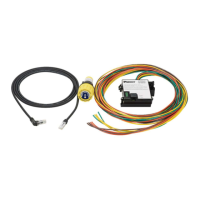© Panduit Corp. 2018
INSTRUCTION MANUAL VeriSafe AVT
B21075_00 Page: 11 of 20 04-2018
Installation Considerations
This section provides guidelines for installing VeriSafe Absence of Voltage Testers (AVTs). It also addresses several common application
scenarios and describes best practices.
General Information
Before installing the AVT, identify all sources of electrical energy in the equipment. Install the AVT at the point in the circuit where you would
normally test for voltage. The AVT will only test for voltage at the point where it is installed. If there are multiple energy sources or multiple
test points, consider using multiple AVTs.
The AVT may be installed on the supply (line) or load side of an electrical disconnect. When the AVT is installed, mark the test location on the
yellow Instruction Label. Apply this label to outside of enclosure near the Indicator Module.
The Voltage Presence indicators only illuminate red when hazardous AC voltage is detected. The absence of voltage test will verify absence of
any voltage (AC and DC) before the Absence of Voltage Indicator is illuminated green.
The AVT is required to be solidly grounded and bonded to the protective conductor terminal of the enclosure. Review the Schematics section
of this Instruction Manual. Although the absence of voltage threshold is 3.0 V, residual voltages should be less than 1.3 V to ensure optimal
reliability.
When installing an AVT, care should be taken to ensure that Sensor Leads used to connect the AVT to the circuit conductors and to ground
shall not be any longer than necessary and shall be routed to avoid sharp edges, pinch points or mechanical damage. Do not extend the sensor
leads with a splice.
Always follow instructions in this Instruction Manual. Do not exceed specified environmental or performance limits.
Effect on Short Circuit Current Rating (SCCR)
AVTs listed to UL 1436 are required to operate as a secondary circuit that is isolated from the circuit conductors by use of a transformer, optical
isolator, or limiting impedance, or other similar means. This is intended to reduce the risks of both electric shock and thermal hazard. These
isolation circuits allow very limited current flow, if any, through the AVT.
The VeriSafe AVT is suitable for use on circuits delivering up to 300,000 rms symmetrical A at 600 V.
Use of Overcurrent Protection
Installation of an AVT with overcurrent protection is neither required nor recommended. When testing for the absence of a signal, it is
important to ensure that the tester is in direct contact with the circuit test point. Installing overcurrent protection between the AVT and test
point could lead to false readings. For example, if a fuse is installed between the circuit test point and the AVT, it is possible that voltage could
be on the line and not be detected by the AVT if the fuse is open.
The circuits in the VeriSafe AVT Isolation Module that are intended to be in contact with the branch circuit are designed to provide isolation
during normal and single-fault conditions. The VeriSafe AVT has been tested to withstand transient
overvoltage up to 6kV.
The sensor leads of the AVT can be treated as a feeder circuit per NEC article 240.21(B)(1)(b) Exception (NFPA 70:2017). This rule allows a tap
of no more than 10 feet on a feeder circuit without the need for overcurrent protection.
Termination Recommendations
The VeriSafe AVT is provided with a total of (8) 14 AWG (2mm
2
) sensor leads (two sensor leads for each phase conductor and ground connection
point). Sensor leads for each phase and ground must not be mechanically connected to each other for the AVT to function properly (see step
7 in the Installation Instructions). The second lead on each phase provides the ability for the AVT to verify that it is in contact with the circuit
conductors (each phase and ground) when the absence of voltage test takes place. It is also part of the mechanism that is used to “test-the-
tester” to validate that the AVT is functioning. There is no maximum distance limitation between the two leads on each phase, however there
should not be any circuit elements installed between them. Do not extend the sensor leads with a splice. Use approved connection methods
and follow local codes and standards when terminating the sensor leads.
Terminations should be made via a tap to the circuit conductor using connectors, terminal strips, or power distribution blocks, etc. which are
rated for the application. It is generally preferred to use connection methods that do not pierce or otherwise compromise the integrity of the
conductor. Connectors that require conductors to be cut or spliced can be used but may limit the SCCR.

